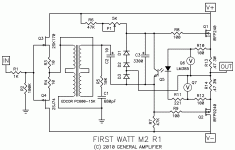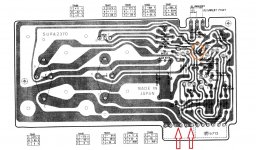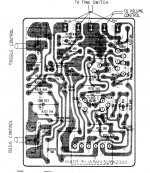What would happen if I replace some polar (plus minus) capacitors with non polar ones (film) inside amp ??.
The amp can gate damaged ?. I want to improve the sound.
There is certain room inside amp to switch to film .
What is the reason they use polar caps ? is about cutting the cost ?.
Thanks
The amp can gate damaged ?. I want to improve the sound.
There is certain room inside amp to switch to film .
What is the reason they use polar caps ? is about cutting the cost ?.
Thanks
In which position will you swap them?
If it is in the signal path and your new caps are good quality the sound should improve.
Tell us more: type of cap; schematics.
Good luck.
M.
If it is in the signal path and your new caps are good quality the sound should improve.
Tell us more: type of cap; schematics.
Good luck.
M.
The amp can gate damaged ? I want to improve the sound.
What is the reason they use polar caps ? is about cutting the cost ?
You will not damage the amp, but changing to film is unlikely to improve the sound unless the capacitors are in the signal path as indicated by maxlorenz.
Polar electrolytic caps are both smaller and less expensive than film capacitors of the same capacitance value .
I have done that on a Nelson Pass "First Watt" M2 amplifier. I was very pleased with the results.
The schematic, drawn by Nelson Pass himself, is attached below. You can also read all about it on this diyAudio thread:
The original schematic calls for capacitor "C2" to be an electrolytic. I replaced it with a nonpolar electrolytic capacitor, a Nichicon MUSE, from their "UES" product line. Those are the Nichicon caps with the bright green sleeves around the cylindrical cans. Just to be needlessly specific, here's a link to the exact capacitor I bought, on Mouser.com: click-me
I expect you can easily understand why I left C3 as a polar electrolytic 🙂
Nichicon also sells a line of polar electrolytic capacitors in brown sleeves. I didn't use those. I used the nonpolar electrolytics in green sleeves.
_
The schematic, drawn by Nelson Pass himself, is attached below. You can also read all about it on this diyAudio thread:
The original schematic calls for capacitor "C2" to be an electrolytic. I replaced it with a nonpolar electrolytic capacitor, a Nichicon MUSE, from their "UES" product line. Those are the Nichicon caps with the bright green sleeves around the cylindrical cans. Just to be needlessly specific, here's a link to the exact capacitor I bought, on Mouser.com: click-me
I expect you can easily understand why I left C3 as a polar electrolytic 🙂
Nichicon also sells a line of polar electrolytic capacitors in brown sleeves. I didn't use those. I used the nonpolar electrolytics in green sleeves.
_
Attachments
What is the reason they use polar caps ?
Cause they're mean and enjoy torturing people with bad sound. Only the brightest can see through the conspiracy.
Depolarising for a better future! 😎
Depolarising for a better future! 😎
Salt and water are polar molecules, oil and grease not. We need both!
It;s a Technics SU-3500.In which position will you swap them?
If it is in the signal path and your new caps are good quality the sound should improve.
Tell us more: type of cap; schematics.
Good luck.
M.
The cap I want to change is the 33uf polar one .
I posted a photo showing the cap location .
Attachments
Last edited:
Have you sourced a 33uF film capacitor that will fit into this location? If so, there's nothing to stop you going ahead!I posted a photo showing the cap location.
Electrolytic capacitors when used with the proper bias voltage do not degrade sound. IMHO. If the amp is more than 20 years old, it is likely the capacitor is drying up, high ESR and should be replaced with another electrolytic of the same voltage rating.
If you have overhead space for a polyprophylene capacitor about 3 cm diameter and 8 cm long, here is a 33 uf for $10 + freight. Audyn Cap Q4 33uF 400V MKP Metalized Polypropylene Foil Crossover Capacitor
The advantage of plastic film, it will never again need to be replaced. I typically replace .47 to 10 uf electrolytic caps with plastic, so I won't have to do it again. I might live 40 more years, and one amp I've had to replace electrolytics 4 times in the 49 years I've had it.
If you have overhead space for a polyprophylene capacitor about 3 cm diameter and 8 cm long, here is a 33 uf for $10 + freight. Audyn Cap Q4 33uF 400V MKP Metalized Polypropylene Foil Crossover Capacitor
The advantage of plastic film, it will never again need to be replaced. I typically replace .47 to 10 uf electrolytic caps with plastic, so I won't have to do it again. I might live 40 more years, and one amp I've had to replace electrolytics 4 times in the 49 years I've had it.
Last edited:
Electrolytics are small and cheap. They can, if misused, add a little distortion; a good designer will not misuse them.
Film caps are much bigger and may be more expensive in the larger values. They can, if misused, create problems such as more hum pickup, oscillation etc.; an unsuspecting 'upgrader' can sometimes misuse them.
Film caps are much bigger and may be more expensive in the larger values. They can, if misused, create problems such as more hum pickup, oscillation etc.; an unsuspecting 'upgrader' can sometimes misuse them.
yep is the one that I surrounded with orange
should I expect some sound improvement if I do that ?
Also I'm still afraid that I might damage the amp .
A guy mentioned
"generally, the 3uf or less polarized caps on the inputs/outputs of certain sections can be changed without fear - like in the tone control, just before the differential inputs, the phono section.
there are other low values in or near the stereo decoder section usually as dc blocks on the chips (if present) I am not sure if they can go bp"
So he mentioned that BP work safe only for low values in certain locations ..
Also regarding the tone circuit board I was thinking to replace all the electrolitycs with BP film . There are a few electrolytics on the tone board including a 47UF BP electrolityc !! .Maybe replacing that one is really important ?
should I expect some sound improvement if I do that ?
Also I'm still afraid that I might damage the amp .
A guy mentioned
"generally, the 3uf or less polarized caps on the inputs/outputs of certain sections can be changed without fear - like in the tone control, just before the differential inputs, the phono section.
there are other low values in or near the stereo decoder section usually as dc blocks on the chips (if present) I am not sure if they can go bp"
So he mentioned that BP work safe only for low values in certain locations ..
Also regarding the tone circuit board I was thinking to replace all the electrolitycs with BP film . There are a few electrolytics on the tone board including a 47UF BP electrolityc !! .Maybe replacing that one is really important ?
Attachments
I saw an important quantity of WIMA capacitors in line filters inside power supplies and frequency converters for industry applications, severely degraded in their nominal value (sometimes less than 1% or less of its nominal value) or completely open and including those completely exploded and catched fire.
How old is this amp? If the electrolytics are in tolerance, likely you will hear no improvement. If the electrolytics are dried up, replacing with industrial electrolytics likely will result in improvement. Technics was not a bargain brand, don't know how short life the electrolytics are likely to be. Most bargain brands, they are all **** after 10 years. Premium brands, electrolytics can last 20 years if not stressed. An ESR meter can tell, but once an amp or radio has problems, I usually change them all. I use the longest service life caps I can buy, 3000 hours for big ones and 10000 hours for little ones, so I don't have to do the job again. Reliable brands of electrolytics I've used have been nichicon, rubicon, panasonic, multicomp, vishay. Somewhat sleazier life test but performed okay have been CDE & United Chemicon. Manufacturers put **** caps in to make sure you buy a new product in 5 to 10 years. Also to keep their price down to maintain precious store shelf space.
NP is a designation only for electrolytics, meaning non-polar. Certain designs require them. Don't ever replace a ### (volts) NP cap with a polar one, it may explode.
Plastic film caps are all non-polar. The outer wrap may be marked, but that is only important for RF applications.
I've replaced dozens of electrolytics in radios & organs with plastic film or ceramic caps. None has been a problem. In general, do one part at a time, then sound test to see if you made the circuit better or worse. The biggest problem I have is cold solder joints, not oscillation or distortion. 2nd biggest problem is lifting the land off the PCB with too much heat.
NP is a designation only for electrolytics, meaning non-polar. Certain designs require them. Don't ever replace a ### (volts) NP cap with a polar one, it may explode.
Plastic film caps are all non-polar. The outer wrap may be marked, but that is only important for RF applications.
I've replaced dozens of electrolytics in radios & organs with plastic film or ceramic caps. None has been a problem. In general, do one part at a time, then sound test to see if you made the circuit better or worse. The biggest problem I have is cold solder joints, not oscillation or distortion. 2nd biggest problem is lifting the land off the PCB with too much heat.
Last edited:
This capacitor doesn't have to work and will be fine even after 43 years. If you feel it should be replaced use a tantalium type of 33 uF/6.3 V as it will fit. The giant Audyn will be problematic as you will have to lash it somewhere off the board with long leads which could pick up noise and hum. But I doubt that you will hear a difference as this amp is rather simple. It is well designed for its time though.
Tjerk
Tjerk
A noble endeavour, but you have been obsessing about it for a long time nowWhat would happen if I replace some polar (plus minus) capacitors with non polar ones (film) inside amp ??.
The amp can gate damaged ?. I want to improve the sound.
There is certain room inside amp to switch to film .
What is the reason they use polar caps ? is about cutting the cost ?.
Non designers sometimes assume that a better design is just the same old tired one but with "better parts".25th June 2017
Improving the Technics SU-3500 amp. What to replace ??
Hi again .
I also have an old Technics SU-3500 that I want to improve .
When i listen to this amp I have the feeling that the whole signal is filtered by a cap or something .
I mean all music sounds pretty the same with this amp .
The sound is like a good tube emulation but the input signal is filtered by something that adds a big signature to the sound by covering big part of the original recording character .
Well, it´s way more complex than that.
Won´t waste time quoting old proverbs about applying lipstick to pigs, etc. but unless you have a *definite* problem with a capacitor (as in: it´s blown, leaking, dry, ESR went through the roof, etc.) you will not solve a problem which is not there.
Do you perceive a blanket covering sound?
Maybe so, but remember it´s a **1976** design, and you are doing nothing to correct that.
Old parts? .... might be a problem if they were original but you posted:
and I assume you used the best you could get, so ....18th August 2018
I started the mod and replaced all caps
Clearly that did not solve your problem, so you insist by now trying to use different cap type ..... but ..... what if you mis diagnosed the problem to begin with?
What if what you hear is a 42 year old design and not "bad/cheap parts"?
And if you keep messing with it you will ..... oh, I guess you already did:
18th August 2018, 05:52 AM
robert2017 diyAudio Member
I damaged my Technics SU-3500 amp
I started the mod and replaced all caps but I made a big mistake.
I installed the two main 10000uf filter caps backwards .
I installed the 342 amp negative blue wire to the positive side the cap and the 341 amp red positive wire to the negative side of the second cap.
I blew the 2A fuse .and more damage was done
How can I fix this ? What should I expect ?
After I replaced the wires in normal position a channel was ok but now the protection relay has stopped working so both channels are dead.
In such situation how many components need replacement ?.
Maybe some transistors need replacement ? and fill work as new ?.
What transistors or components I need to replace ?
I have this amp for 10 years.
After working for 3 days to replace all caps I don't wanna give up . I already put to much effort so I can't believe is not working
Help !
Can´t you just enjoy your fine and properly working amplifier?
Just sayin´ 🙂
JMFahey,
Thanks for the sleuthing!
This thread should now be closed before the capacitor debate gets out of hand yet again.
Mods?
Thanks for the sleuthing!
This thread should now be closed before the capacitor debate gets out of hand yet again.
Mods?
You are a "weirdo" individual )))) loollll ha haA noble endeavour, but you have been obsessing about it for a long time now
Non designers sometimes assume that a better design is just the same old tired one but with "better parts".
Well, it´s way more complex than that.
Won´t waste time quoting old proverbs about applying lipstick to pigs, etc. but unless you have a *definite* problem with a capacitor (as in: it´s blown, leaking, dry, ESR went through the roof, etc.) you will not solve a problem which is not there.
Do you perceive a blanket covering sound?
Maybe so, but remember it´s a **1976** design, and you are doing nothing to correct that.
Old parts? .... might be a problem if they were original but you posted:
and I assume you used the best you could get, so ....
Clearly that did not solve your problem, so you insist by now trying to use different cap type ..... but ..... what if you mis diagnosed the problem to begin with?
What if what you hear is a 42 year old design and not "bad/cheap parts"?
And if you keep messing with it you will ..... oh, I guess you already did:
Can´t you just enjoy your fine and properly working amplifier?
Just sayin´ 🙂
But to answer you're "weirdo" post I was able to fix the amp by replacing TR506 and TR501 and first I changed all caps with new ones.
I used the amp for 10 years with the original caps so the signal was always bad .
Now with new caps it sounds very good .
I was just thinking if replacing some NP with BP will help ...
I measured the resistors and they are fine....
Is 42 years old from the audio golden era .
Last edited:
- Status
- Not open for further replies.
- Home
- Member Areas
- The Lounge
- replacing polar electrolytics with non polar caps inside amp


